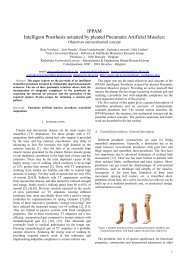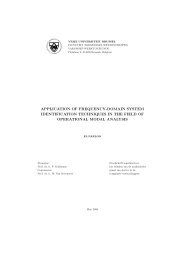VRIJE UNIVERSITEIT BRUSSEL Acoustics - the Dept. of ...
VRIJE UNIVERSITEIT BRUSSEL Acoustics - the Dept. of ...
VRIJE UNIVERSITEIT BRUSSEL Acoustics - the Dept. of ...
Create successful ePaper yourself
Turn your PDF publications into a flip-book with our unique Google optimized e-Paper software.
96 CHAPTER 5. SOUND INSULATIONblocked by <strong>the</strong> material <strong>of</strong> <strong>the</strong> screen or panel, but <strong>the</strong> sound also travelsfrom <strong>the</strong> source to <strong>the</strong> receiver in an indirect way because <strong>of</strong> diffraction (seeFigure 5.6). In order to calculate <strong>the</strong> total sound reduction one has to take<strong>the</strong> diffraction into account. The diffraction is dependent on <strong>the</strong> wavelengthλ and <strong>the</strong>difference d between <strong>the</strong> direct distance fromsource to receiver and<strong>the</strong> indirect distance. The following equation gives an approximation <strong>of</strong> <strong>the</strong>sound reduction index for screens outdoors (no reflection from <strong>the</strong> ceiling) :( )λR = −10log(5.39)3λ+20dFigure 5.6 shows <strong>the</strong> graph for a frequency <strong>of</strong> 1000 Hz. Obviously onehas to be careful with <strong>the</strong>se calculations. The noise level cannot be reducedmore than <strong>the</strong> surrounding noise level. The surrounding noise can also begenerated by a roadway, railway or an airport at a distance, traffic, industry,etc.In practice, in an industrial environment, one has to place <strong>the</strong> screen insuch a way that an angle <strong>of</strong> 60 degrees between <strong>the</strong> source <strong>of</strong> sound and <strong>the</strong>receiver is obtained (see Figure 5.7).
















